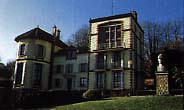It was at Médan that Zola composed a large portion of Rougon-Macquart, natural and social history of a family under the Second Empire. There he wrote, among others, Nana, Germinal and La Terre (The Earth).
Acquired in 1878, thanks to the success of L'Assommoir, the Médan house permitted Zola to associate his name with a geographic place, just like Flaubert had done with Croisset or Hugo with Jersey and Guernsey.
Not wanting to be far from Paris or the next World Fair, Zola bought that which he called “a rabbit hutch” situated fifty meters from a railroad which gave him the inspiration for La Bête Humaine. Residing for eight months out of the year at Médan, from the beginning of summer to January 1, the writer did not cease enlarging his property which in twenty-four purchases passed from 1,200 to 42,000 square meters.
The addition of a massive brick and cement building destined to house the writer's study then, in 1885, that of a symmetrical tower with slanted walls, overwhelmed the small original house which was gripped between them.
In 1880, Zola acquired the Isle of Médan where he had built the Norwegian chalet presented at the 1878 World Fair. In 1882, he had constructed the “Charpentier Pavilion,” christened after the name of his editor, where he welcomed his guests. He actually received a number of his relations at Médan: journalists, writers, men of the French theater and foreigners. His closest friends came regularly to stay there, among them Vallès, Daudet, Goncourt, Mirbeau, Cézanne (until their disagreement over the appearance of L'Oeuvre in 1886) and naturally the five authors of Soirées Médan: Paul Alexis, Henry Céard, Léon Hennique, J.K. Huysmans and Guy Maupassant. For this piece published in 1880, each of them wrote a short story on a common theme: the French-German war of 1870. This collective work, of which the most famous story remains Maupassant's Boule de Suif, was considered the manifesto of naturalism because of its title, a veritable hommage to the master of Médan.
September 28, 1902, Zola left his property for the last time; he died of suffocation in his Paris apartment the same night. The writer's widow made a gift of the Médan house to Public Assistance in 1905. The association of the Zola Museum opened it to the public in 1985. In the original house, the dining room and the covered ceiling ordered by Zola still remain. In the adjacent buildings, constructed at the will of the writer, a few rooms have retained their original decoration, like the magnificent ceramic tiled kitchen and the dining room with its imitation Cordoba leather covered walls and its medieval stained-glass windows.
The writer's study remains one of the more interesting rooms of the estate. An immense square space dominated by a large bay window overlooking the Seine, it possesses a monumental Renaissance fireplace bearing the motto of Zola on the hood: Nulla dies sine linea (not a day without a line). Finally, the billiard room displays an ornate ceiling with the Zola family coat of arms, a fireplace which conserved its fleur-de-lis decorated taque and two splendid stained-glass windows executed by Henri Baboneau following the instructions of the writer himself. A number of photographs, a passion of Zola's, line this visit and bear witness to the particular style of the dwelling where a multitude of furniture and pieces of art are amassed.
Home of Zola


